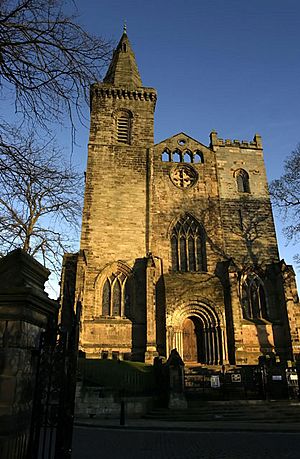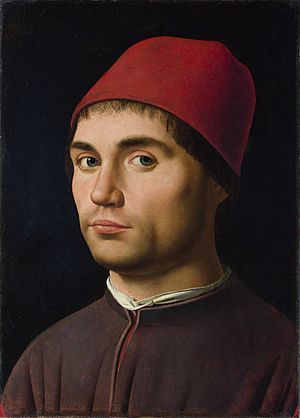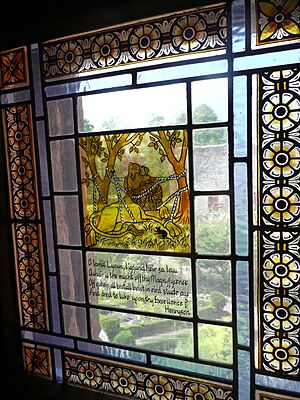Robert Henryson facts for kids
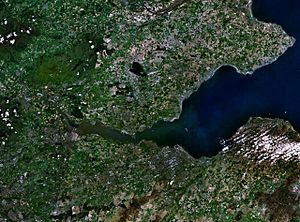
Robert Henryson (also known as Robert Henrysoun in Middle Scots) was an important poet in Scotland from about 1460 to 1500. He was one of the famous Scottish poets called makars. Henryson lived in the royal town of Dunfermline. His writing shows a mix of old medieval ideas and new Northern Renaissance styles.
We don't know much about his life. But it seems he was a teacher who also studied law and other subjects. He likely had a connection to Dunfermline Abbey. He might have also worked at Glasgow University for a while. He wrote his poems in Middle Scots, which was the official language of Scotland at that time. Most of his work is storytelling poems. We still have almost 5000 lines of his poetry today.

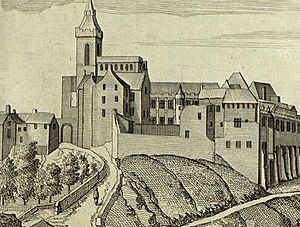
Contents
Robert Henryson's Writings
Henryson's poems that we still have include three long poems and about twelve shorter ones.
Long Poems
His longest poem is Morall Fabillis. This is a collection of thirteen fable stories, almost 3000 lines long. Fables are short stories, usually with animals, that teach a moral lesson.
He also wrote two other long poems, each over 600 lines:
- The Tale of Orpheus and Erudices his Quene: This is his own creative version of the ancient Greek story of Orpheus.
- Testament of Cresseid: This sad story continues the tale of Criseyde from Chaucer's famous poem Troilus and Criseyde. It explores deep moral and emotional ideas.
Short Poems
Henryson's shorter works cover many different topics:
- Robene and Makyne: A love poem.
- A funny poem that makes fun of doctors from his time.
- A beautiful poem about Mary, the mother of Jesus.
- Some poems that use allegory (stories with a hidden meaning).
- Poems about deep thoughts and ideas.
- A prayer asking for protection from the plague.
It's hard to know exactly when Henryson wrote each poem. His Orpheus story might have been written when he was in Glasgow, as he used a book from the university library for it. Some clues suggest he wrote the Morall Fabillis in the 1480s.
About Robert Henryson's Life
We don't know when or where Henryson was born or where he went to school. The first possible mention of him is on September 10, 1462. A person named Robert Henryson, who was allowed to teach, took a job at the new University of Glasgow. If this was the poet, it means he had studied both arts (like literature and philosophy) and canon law (church law).
Most early records connect Henryson to Dunfermline. He probably worked closely with the city's Benedictine abbey. This abbey was a very important place. Many Scottish kings were buried there, and it was a major stop for pilgrims on their way to St Andrews. In 1478, his name appeared as a witness on documents from the abbey. If this was the poet, it means he worked as a notary for the abbey. A notary is someone who makes sure legal documents are correct. The abbey owned a lot of land across Scotland.
People usually say Henryson was a schoolmaster. This means he likely taught at the grammar school in Dunfermline. This school was for the abbey town. In 1468, there was a plan to build a "suitable" house for a "priest" (who would be the master of grammar) and "scholars" in Dunfermline. This included "poor scholars being taught free of charge."
Dunfermline was a royal town and sometimes the capital. The royal court often visited, and the king's home, Dunfermline Palace, was connected to the abbey. We don't have records of Henryson being a court poet. But because he lived so close, he probably knew the royal family. He was active during the reigns of King James III and King James IV, both of whom loved literature.
The poet William Dunbar said that Henryson died in Dunfermline. An old story from the early 1600s says he died from a disease called the flux. However, this is not confirmed. We also don't know the exact year he died. Some people think it was around 1498-1499, when the plague was in Dunfermline. Dunbar wrote a poem around 1505 that simply says Death "whispered in private" with "Master Robert Henryson" in Dunfermline.
We know almost nothing else about Henryson's life, apart from what we can guess from his writings. We don't know if he was from Dunfermline originally. Some people think he might have been connected to the Henderson family in Fife, but we can't prove this.
Robert Henryson's Style
Henryson usually wrote in the first person, using a friendly tone. This makes readers feel like they know him and understand his personality and beliefs. His writing stays connected to everyday life. It feels real even when he talks about deep ideas or uses fantasy elements.
His language is clear, smooth, and to the point. He wrote in Scots and clearly knew Latin. He often described Scottish places in a way that shows he knew them well. This detailed and realistic approach sometimes suggests he was writing about his own experiences or current events. But the exact details are often unclear, which makes his work even more interesting to readers.
We can't learn specific facts about his life directly from his poems. But some parts, especially at the beginning of his Testament of Cresseid, seem to show his own thoughts and feelings.
Henryson's Scots Language
Henryson wrote using the Scots language of the 15th century. This was a time when many parts of Europe started using their local languages for literature instead of Latin. Latin had been the main language for writing across the continent for a long time.
Known Poems by Robert Henryson
Here are all the poems we know were written by Robert Henryson. A scholar named Matthew P McDiarmid also found a lost poem by Henryson that started: On fut by Forth as I couth found.
Long Works
- The Morall Fabillis of Esope the Phrygian (See below for a list of the individual fables in this collection)
- The Tale of Orpheus and Erudices his Quene
- The Testament of Cresseid
Short Works
- Robene and Makyne
- Sum Practysis of Medecyne
- The Annuciation
- Ane Prayer for the Pest
- The Garment of Gud Ladeis
- The Bludy Serk
- The Thre Deid-Pollis
- Against Hasty Credence
- The Abbay Walk
- The Praise of Age
- The Ressoning Betwix Aige and Yowth
- The Ressoning Betwix Deth and Man
Individual Fables from The Morall Fabillis
Seven of Henryson's fables come from old Aesop stories. The other six (shown in italics) are like the Reynard the Fox tales. The three titles with bold numbers show how the whole collection fits together.
- 01 The Cock and the Jasp
- 02 The Twa Mice
- 03 The Cock and the Fox
- 04 The Confession of the Tod
- 05 The Trial of the Tod
- 06 The Sheep and the Dog
- 07 The Lion and the Mouse
- 08 The Preaching of the Swallow
- 09 The Fox the Wolf and the Cadger
- 10 The Fox the Wolf and the Husbandman
- 11 The Wolf and the Wether
- 12 The Wolf and the Lamb
- 13 The Paddock and the Mouse
|
See also
 In Spanish: Robert Henryson para niños
In Spanish: Robert Henryson para niños


